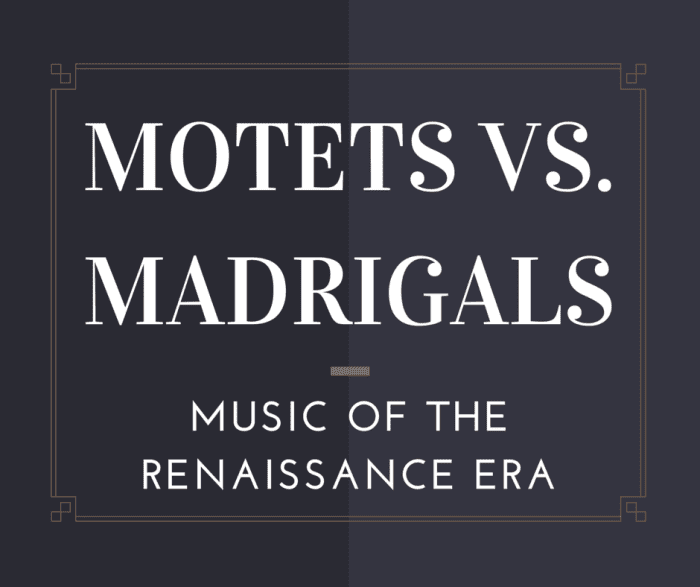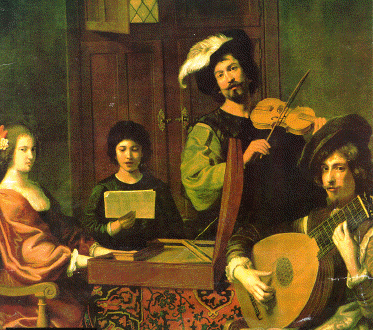The Art of Creating a Musical Picturalization of the Words of a Madrigal Text Is Known as
Motets vs. Madrigals: Music of the Renaissance Era

What is the difference betwixt a motet and a madrigal?
Music of the Renaissance Era
Due to the revival of interest in art and literature during the Renaissance Era, polyphonic music became the favored mode of musical composition. Nonetheless, in order to maintain the divide betwixt sacred and secular music, two distinctive polyphonic styles were created: the motet and the madrigal. These two styles take meaning similarities and differences that continue to have an issue on our music today!

Understanding the Nuts/Groundwork
Polyphony is a musical composition that uses simultaneous but multiple independent melodic parts, lines, or voices. During the Renaissance era, polyphonic music became widespread throughout in both sacred and secular settings due to the revival of interest in art and literature. The nearly favored styles of music during this catamenia was the motet, for sacred topics, and the madrigal, for social themes.
To reinforce the divide between the 2 forms, motets were in the Latin text, while madrigals were in the colloquial languages—French, Italian, or English. Although both adopted expressive wordings and the melodies became more defined every bit polyphony developed during the Renaissance era, the two types of music yet contain many basic or complex similarities and differences within their musical composition and techniques.
Similarities
Hither are the basic similarities:
- Homophonic textures:
Homophonic textures is a term describing when two or more parts with a unmarried melodic line move together in harmony. Such a song will consist of a single melody supported by chords. Imagine a choir with anybody in i group singing the same melody in unison while another sings in harmony, creating chords. The prefix "homo" means "the same." - Polyphonic textures:
Polyphonic textures is a term describing a musical composition that uses two or more simultaneous simply independent melodic parts, lines, or voices. Think of a man singing one melodic part and a woman singing a separate melodic part at the same time. The prefix "poly" means "many." - Imitation techniques:
The procedure of repeating a melody immediately at another part or point to cause overlap. It is important not to confuse this with polyphony.
For example, faux in a duet between a man and a woman occurs when the man sings the base tune and the woman sings the same melody a shell or two later him.
Differences
| Motet | Madrigal |
|---|---|
| Sacred topics | Social themes, stories |
| Latin | Vernacular languages |
| Polish and predictable | May contain dissonance, sudden cadences, or word paintings for accent |
To Assistance With Polyphony versus Homophony
Scroll to Continue
Read More From Owlcation
The Motet
It is important to note that although there are similarities in the techniques and styles of motets and madrigals, there are slight contrasts that create substantial differences in the sound of the music.
- Motets are sacred choral works performed in worship services. A holy musical piece such equally "Ave Maria, Gratia Plena" is intended for sacred events and services.
- Motets accept a much more strict manner in comparison to madrigals. They have piffling emphasis or accent on words, and the expression in the music is much more cultured and polite to fit the sacred settings; it has no edginess to its sound.
- Harmonies tend to exist very smooth and predictable. In "Ave Maria, Gratia Plena," different voices distinctively perform their parts in a very smooth and elegant manner as the voices weave together. The strict motet structure is axiomatic in this piece because it does not contain any dissonance or sudden cadences. The music smoothly transitions from layer to layer, and texture to texture.
- The different voices never really overpower each other. All singers repeat and overlap 1 some other to create more than texture, while maintaining the identity of their atypical voice in the music. The voices blend clearly even when the parts become more melismatic, or several notes are sung on one syllable.
Motet example: "Ave Maria, Gratia Plena" past Josquin Des Prez
The Madrigal
Madrigals comprise many small differences that help give it its own identity.
- Madrigals are about secular topics of love, humor, and scenery presented at home or social gatherings. Madrigals also depict topics of hate, grief, fear or shock. In a Renaissance piece past Thomas Weelkes chosen "As Vesta Was Descending," the lyrics tell a story and would never be played in a church building setting.
- They may really include dissonance—another course of homophony—instead of harmonies if a musical piece demands negative emotional expression.
- Madrigals have a completely dissimilar sound than motets due to the employ of give-and-take paintings, which are different musical techniques that illustrate, emphasize, and interpret the special meaning of a give-and-take to brand it clearer and more obvious than the words effectually it. A change in the tone, texture, volume, or range tin can depict a discussion painting. They consist of highly expressive methods while as well utilizing surprising harmony and dissonance. For example, a rise scale of notes could place accent on the word "ascending" in a vocal. In addition, a descending scale could emphasis the words "running down." A more complex word painting could illustrate the idea of spying or sneakiness by lowering the tone and book of the voice to be soft and discrete. A strange nonetheless valid discussion painting would be a vocal mimicry of bird trills to stand for birds or a ding equally if someone had an thought and a light bulb turned on in his or her head. All of these word paintings make the music more than expressive and comprehensible and are a major divergence betwixt motets and madrigals.
Madrigal Example: "Every bit Vesta Was Descending" by Thomas Weelkes
All in All...
Although motets and madrigals all utilized imitation and homophonic techniques to create polyphonic (multi-layered) textures, there is still a clear divergence that separates the two styles, which makes motets and madrigals suitable for their ain respective settings. The newly favored choral music of the Renaissance era struggled with finding a residuum between music for worship and music for enjoyment. The contrasts between the ii styles were non very axiomatic at showtime and took time to develop. However, as acceptance of motets and madrigals increased in the religious and social segments of Renaissance guild, the music became more circuitous and varied. Ultimately, this advancement in musical composition led to major distinctions between motets and madrigals despite the similar techniques the two styles used. The motet and madrigal and eventually paved the mode for future musical styles.
Mirjana milutinovic from Sid on September 04, 2018:
I retrieve it equally a child
Related Articles
Source: https://owlcation.com/humanities/Music-of-the-Renaissance-Era-Motets-vs-Madrigals
0 Response to "The Art of Creating a Musical Picturalization of the Words of a Madrigal Text Is Known as"
Post a Comment